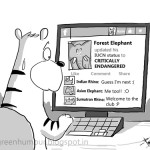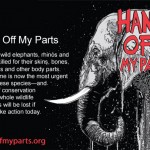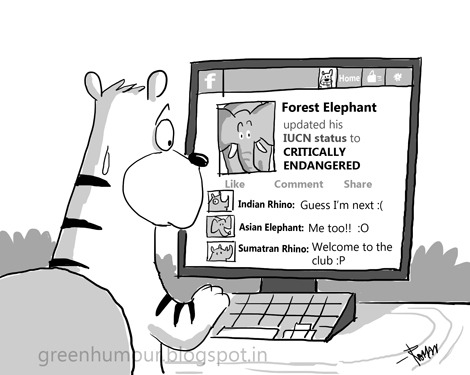 Dissemination of information has never been easier then at this very moment. The Internet, specifically social media sites, allows us to share concerns regarding wildlife and bring attention to important conservation issues instantly with people around the world. Case in point, you are reading this blog. Unfortunately, along with the potential good this kind of technology brings there is also the bad. With millions of daily tweets, Facebook status updates, Youtube videos, Instagram pictures, Flickr uploads, and blog posts one cannot help but ask if this actually helps or hinders wildlife conservation.
Dissemination of information has never been easier then at this very moment. The Internet, specifically social media sites, allows us to share concerns regarding wildlife and bring attention to important conservation issues instantly with people around the world. Case in point, you are reading this blog. Unfortunately, along with the potential good this kind of technology brings there is also the bad. With millions of daily tweets, Facebook status updates, Youtube videos, Instagram pictures, Flickr uploads, and blog posts one cannot help but ask if this actually helps or hinders wildlife conservation.
There are not too many wildlife conservation organizations that do not have a presence on the World Wide Web. Websites linked to Facebook, Twitter, and Youtube give followers daily updates on research and related topics that affect the species they care most about. Wildlife poaching for ivory, horn, bones, or fur, deforestation within the Palm Oil industry, shark finning, and human-wildlife conflict are only a few topics that can be found every hour in our newsfeed. However, does this inundation of pictures and updates result in people wanting to help or hide? I have studied elephants for over 13 years. I am all too aware of the current situation in range countries with the rampant poaching for ivory. I have seen more then my share of pictures of poached elephants with faces removed for ivory collection. That said, it is starting to become a bit much for even a seasoned conservationist to constantly see posts containing graphic pictures of dead animals. I have friends that ask why those working in the realm of wildlife conservation want to continually look at these horrific images. The truth is, we don’t. The shock and awe media campaign has always been present in wartime journalism. Poaching is definitely a war against wildlife. I suppose it is a given that reporting from the front lines, regardless of subject, uses raw images to show the reality of a given situation. However, the reality is it turns people away.
Catching wildlife perpetrators who willingly participate in illegal wildlife trade has become a little easier thanks to the web. Facebook is a popular place for individuals to post pictures engaged in leisure activities. On more then one occasion wildlife poaching or harassment has been on display for the entire world to see, including law enforcement officials who regulate and prosecute such stupidity. Unfortunately, those regulating officers are not the only ones patrolling social media sites. Poachers are also scouring social media sites like Facebook and Flickr that not only post pictures but also locations. An animal lover on vacation sharing information regarding endangered flora and fauna they encounter may unknowingly give away their whereabouts allowing for poachers to kill or capture rare species.
Marketplace sites like Ebay have been a thorn in the side of conservationists for a long time. Every imaginable item can be found for sale on Ebay. Aside from bedding, used textbooks, and used-only-once car tires, wild animals and their parts can be purchased. Ebay claims that with the volume of daily sales it is impossible to internally monitor the legalities of items posted on their site. They encourage users to notify them immediately if any questionable items are found. I shudder to think with every one item that is flagged how many go unnoticed. Furthermore, what about those items sold as antiques collected before government regulations were set, listed as faux or replicas when in fact they are real shells, bone, fur, ivory, etc., or those items sold containing undisclosed objects hidden from all but those on the inside of such illegal trade? Most crimes against wildlife are carried out in the open, not behind closed doors.
 No one can deny that the Internet has been instrumental in spreading information concerning wildlife conservation. It has allowed wildlife biologist and conservationists a way to to stay connected as well as share their passion with others about the places and species they love. But, does awareness result in action? For all of the good intentions, how much of what we share is used to unknowingly harm instead of help wildlife? Or is our need to over share turning people away from our cause? As a society we rely far too much on others for regulation. We live in an age where an unlimited amount of information is at our fingertips; information that is ever changing and evolving. Be aware of what you post and how others perceive your words or pictures. Think before you share!
No one can deny that the Internet has been instrumental in spreading information concerning wildlife conservation. It has allowed wildlife biologist and conservationists a way to to stay connected as well as share their passion with others about the places and species they love. But, does awareness result in action? For all of the good intentions, how much of what we share is used to unknowingly harm instead of help wildlife? Or is our need to over share turning people away from our cause? As a society we rely far too much on others for regulation. We live in an age where an unlimited amount of information is at our fingertips; information that is ever changing and evolving. Be aware of what you post and how others perceive your words or pictures. Think before you share!
